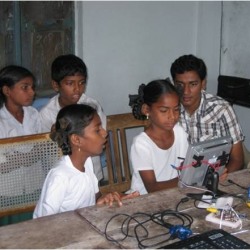
Many of the classrooms in India are short of teachers and devoid of electricity. But what researchers hope they will have are low-cost computer tablets specifically designed for the needs of the students in that country.
Two completely different designs take two entirely different approaches to that challenge.
The first, called the Aakash (which means "sky" in Hindi), was developed for university students by DataWind Ltd. in Montreal in partnership with the Indian Institute of Technology.
What is being touted as the world’s cheapest tablet computer will be sold to students at the subsidized price of $38. The paperback-sized touch-screen device supports Web browsing and video conferencing, uses a 366-MHz Conexant processor, and has two USB ports, 2 GB of flash storage, and a three-hour battery life. It utilizes the Google Android 2.2 OS, uses a resistive 7-in. LCD display with 800 x 480-pixel resolution, and connects to the Web via wireless broadband.
According to DataWind, the configuration of the tablet is adequate for most applications, including high definition-quality video, reading books, and basic office applications. The company says it makes up for the lower speed of the processor by using compression acceleration technologies that shift a part of the processing during Web browsing from the device to the cloud.
Meanwhile, a second, very different approach has resulted in the I-Slate, designed for Indian students in grades 5-6 by a team led by professor Krishna Palem of Rice University.
According to Palem, the I-Slate isn’t a general-purpose computer, such as a laptop or computing tablet, even though it has the same shape and size. It is easier to compare it to the interactive version of the Kindle, he says, where the user can also write and interact with the device while having the Kindle functionality of being able to read documents such as books.
Palem insists he did not take a tablet designed for wealthier countries and lower its quality by using cheaper processes and parts.
"If we think of the world population as a pyramid with fewer and wealthier people at the top and greater numbers of less-wealthy people at the bottom, the I-Slate was deliberately designed for the bottom. Our ‘bottom of pyramid’ design philosophy involved starting with the requirements of the domain
Normal
0
false
false
false
EN-US
X-NONE
X-NONE
—a shortage of teachers and electricity were determined to be the major challenges
Normal
0
false
false
false
EN-US
X-NONE
X-NONE
—and designing the most frugal device possible while maximizing its effectiveness as a teaching tool and tackling those challenges," he said in a recent interview.
The I-Slate uses a 7-8-in. touchscreen display, receives content through a USB device, and is designed to exclusively use 3 watts or less of solar energy via several photovoltaic cells.
Regardless which tablet Normal 0 false false false EN-US X-NONE X-NONE —or design philosophy Normal 0 false false false EN-US X-NONE X-NONE —proves more popular and effective, the question remains whether technology is the best use of dollars in terms of education in India today.
In 2006, while criticizing the One Laptop Per Child program, the late Sudeep Banerjee of the Union HRD Ministry said, "India needs classrooms and teachers much more urgently than it needs fancy tools."
According to Palem, I-Slate bridges Banerjee’s concerns regarding technology.
"A PC with its conventional user interface cannot by itself be effective in teaching when faced with severe shortages Normal 0 false false false EN-US X-NONE X-NONE —of teachers, for example. To overcome this, I-Slate’s interactive experience mimics the process of a student being tutored by a teacher and is tailored to maximize this experience for a given energy and cost investment. Modeled after the engaging environments of video games, the students’ learning experience is meant to be greatly enhanced through the I-Slate. Our effectiveness studies have validated that we can achieve this goal."
Paul Hyman was editor-in-chief of several hi-tech publications at CMP Media, including Electronic Buyers’ News.



Join the Discussion (0)
Become a Member or Sign In to Post a Comment